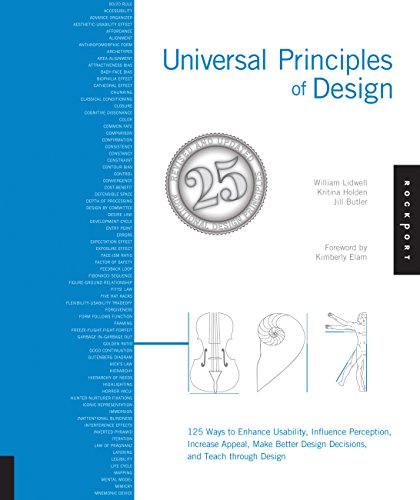Universal Principles of Design, Revised and Updated: 125 Ways to Enhance Usability, Influence Perception, Increase Appeal, Make Better Design Decisions, and Teach through Design
William Lidwell, Kritina Holden, Jill Butler
amazon.com
Universal Principles of Design, Revised and Updated: 125 Ways to Enhance Usability, Influence Perception, Increase Appeal, Make Better Design Decisions, and Teach through Design
William Lidwell, Kritina Holden, Jill Butler
amazon.com
An activity will be pursued only if its benefits are equal to or greater than the costs.
In both cases, the high degree of convergence indicates a stable environment—one that has not changed much over time—and designs that closely approximate the optimal strategies afforded by that environment. The
These effects also describe a general selection preference known as order effects—first and last items in a list are more likely to be selected than items in the middle (e.g., the order of presentation of candidates on a ballot).4
Maximizing signal means clearly communicating information with minimal degradation. Signal degradation occurs when information is presented inefficiently: unclear writing, inappropriate graphs, or ambiguous icons and labels. Signal clarity is improved through simple and concise presentation of information. Simple designs incur minimal performance l
... See morePeople prefer the path of least resistance when making decisions. When the path of least resistance happens to lead to a generally favorable outcome everyone is happy. When the path of least resistance leads to a generally unfavorable outcome, however, the results are problematic. For example, when the default option for new employees is to not be
... See moreThe expectation effect refers to ways in which expectations affect perception and behavior. Generally, when people are aware of a probable or desired outcome, their perceptions and behavior are affected in some way. A few examples of this phenomenon include:1 Halo Effect—Employers rate the performance of certain employees more highly than others ba
... See moreExpository advance organizers are useful when audiences have little or no knowledge similar to the information being taught.
Anthropomorphic forms are appealing when they are dissimilar or identical to humans, but unappealing when they are very similar to humans.
Confirmation is a technique used for critical actions, inputs, or commands. It provides a means for verifying that an action or input is intentional and correct before it is performed.